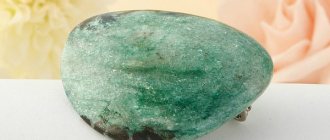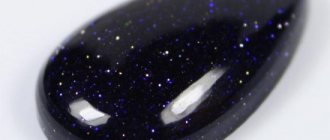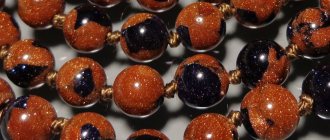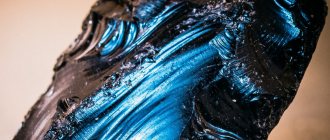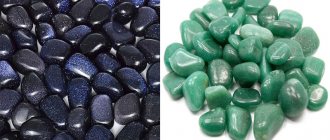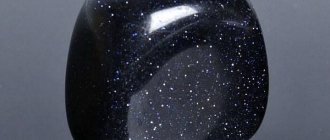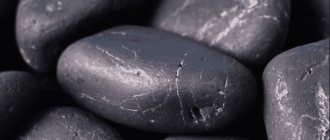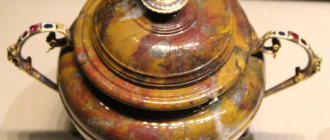Let's figure out who the aventurine stone is suitable for, how to properly care for it, and what healing and magical properties are attributed to it.
History and origin
The jewelry name for this gem - aventurine - goes back to the Romance languages, in particular to French, Italian (Tuscan dialect) and their common predecessor - Latin. The Latin root advenio means "to happen" in the sense of "happening unexpectedly."
Ironically, aventurine was originally called a fake of this stone, obtained in a glass-blowing workshop on the island of Murano near Venice. In the 16th century, a glassblower accidentally dropped a handful of copper filings into the glass mass - the result was multi-colored glass, surprisingly similar to the famous ornamental stone.
Brick-colored aventurine
The original European name for aventurine has not been preserved; the gem was “renamed” in honor of a happy occasion. In Russia of the 17th–19th centuries, a stone speckled with a thousand sparkles was called “gold spark” or “spark” . There is also such a name as aventurine quartz.
This is interesting! In Russian, the jewelry name zlatoiskra is consonant with the word “adventure,” that is, “an ill-conceived risky operation, an adventure.” It must be admitted that from an esoteric point of view, aventurine corresponds to its name 100%.
Blue stone with history
Precious and semi-precious stones served not only as decorations, but also as amulets and talismans for their owners.
Aventurine was valued in ancient Egypt and China. In particular, the seal of one of the emperors of the ruling dynasty of China was made of this stone. It emphasized the status and power of its owner.
In medieval Europe, the mineral was also held in high esteem due to its beauty, depth of shade and rarity. It was this enchanting shade of dark blue color and the peculiar internal shimmer of the stone that became the prototype of the famous Murano glass of dark blue shimmering shades. It is produced on the Italian island of Murano near Venice.
Physicochemical characteristics
From a geological point of view, aventurine is a type of quartzite that has a complex heterogeneous structure. The basis of the stone is quartz, which over millions of years of geological processes has been compressed with particles of mica, hematite, goethite, iron hydroxides and some other substances. The heterogeneity of the structure, combined with chaotic inclusions of coloring substances - chromophores - gives aventurine its characteristic appearance.
| Formula | SiO2 |
| Color | White, pink, yellow, red, brown, green, blue. |
| Shine | Fatty |
| Transparency | Not transparent |
| Hardness | 6 — 7 |
| Cleavage | Absent |
| Kink | Conchoidal |
| Density | 2.6 g/cm³ |
Thanks to its quartz base, it has a high hardness of 6–7 on the Mohs scale. Harder than glass. It polishes well, and after cutting it acquires a slightly greasy shine. Some samples have a noticeable iridescence effect - bluish-yellow iridescent tints at a certain angle of incident light.
Bluish-yellow overflow during processing
Learning to distinguish aventurine from a fake
Much water has passed under the bridge since then. But attempts to create an artificial analogue of aventurine do not stop. How to distinguish a fake from the original? To do this, we need to remember several constants that determine genuine aventurine.
- The first constant is shine. If the sample offered to you has a very high concentration of blisters, you can say with 99.9% confidence that it is a fake. To create it, so-called “aventurine glass” is used. During its manufacture, small particles of copper, chromium, iron and cobalt are placed into the molten glass mass. They, in addition to directly creating a stellar shine, also participate in giving the glass the color required by the glassmaker. For example, copper gives glass a reddish tint, iron gives it a brownish tint, chromium gives it a greenish tint, and cobalt gives it a deep blue tint.
If you make a complex introduction of these metals, the effect will be stunning! We will see glass that looks no different from natural stone. However, a real connoisseur will immediately understand that this is a fake. If you also want to gain the knowledge of an expert, then…
- The second constant is the gloss density. In natural aventurine, the sparkles are unevenly spaced. This is due to the fact that aventurine, being a natural stone, has a granular structure. The flashing elements are located in the intergranular space and cannot be distributed evenly.
As for glass, as you probably remember from your school physics course, it has an amorphous structure, as a result of which particles can accumulate locally where the glassmaker needs it. To do this, you only need to make a few movements, driving the particles into the required area.
- The third constant is the form of blisters (glitters). If you look at aventurine glass through a magnifying glass, you will notice the geometric similarity of each element. Most often this is:
- triangle;
- hexagon;
- circle.
If we talk about real aventurine, then, as a rule, the particles in it have different shapes and glow strengths. This is due to the fact that genuine shine is created by several types of blisters at once. (We remind you: we call inclusions of various types of mica, as well as small crystals of goethite and hematite, blisters).
- The fourth constant is hardness. To find it out, we will have to use the Mohs geological hardness scale. Thanks to it, you can easily determine the approximate affiliation of a mineral to a particular group. The scale is conventionally divided into 10 classes (degrees) of hardness. At the same time, talc, used as powders and additives to tablets, occupies 1st place in it. Diamond, as the hardest mineral on our planet, represents class 10 on the Mohs scale.
But let's return to aventurine. It is confidently located in the hardness zone 7. Glass, on the other hand, occupies only 5th position in this scale. In other words, the hardness of genuine aventurine is 2 orders of magnitude higher than that of aventurine glass.
Now let's talk about what these hardness numbers give us. If we have natural aventurine and its artificial counterpart in brilliance, we can conduct the following experiment. Let's take a stone and try to draw a line with it on the surface of aventurine glass. The line will be clear and obvious. Glass will not leave any marks on the surface of the mineral. If we do not have genuine aventurine, and it is necessary to verify the authenticity of the proposed sample, we can use minerals that have the same degree of hardness as aventurine. This is primarily quartz (rock crystal), as well as garnet and tourmaline.
Mining locations
Aventurine is a fairly common gem found in nature. In Russia, its deposits are located in the Urals, in the town of Taganay (by the way, hence the local name - “taganaite”). Other mining areas are scattered around the world: in Europe they are located in Austria, Spain and Norway, in Asia - in China and India, in the Americas, production is carried out in Chile, Brazil and the USA. It is also found in Australia.
It should be noted that gold sparks of different colors are mined in different deposits . In Asia, green is most common, in the US - golden, and so on.
Colors and varieties
Aventurine has surprisingly many faces - exactly like His Majesty's case. Its main colors are green, honey, gold, cherry, but the color of the spark is not uniform: the main color is “accompanied” by tints, stripes, dots and inclusions of other colors - white, gray, golden, brown, purple. In fact, the stone is painted in very small speckles, and only its background color is clearly identified.
The least common varieties are pink, blue and black. The last two are most highly valued, as they are very beautiful. Alas, for the same reason, blue and black taganaites are the main objects of counterfeiting.
Blue aventurine
Black aventurine
The stone is not smooth to the touch, but fine-grained. The grain size varies among different subspecies, since it depends on the conditions in which the stone was formed. The main types of defects are large pores and shagreen.
The most common types:
- green with dark and light splashes, the so-called “Indian jade”;
- golden-cherry - burgundy stone with golden inclusions, very beautiful;
- plain cherry brown;
- yellow honey-colored, distinguished by a characteristic “spark”;
- uniform pinkish-white;
- white striped;
- cherry white striped.
Blue and blue-black gems are much less common. They can have golden, grayish, white and purple inclusions. Golden cherry has the smallest grain size and is the smoothest to the touch. This is exactly what the accidentally invented “Murano glass” with the addition of copper filings turned out to be similar to . Now it is known as aventurine.
Bracelet made of golden cherry aventurine
What kind of mineral is aventurine?
Aventurine belongs to the quartz group and is opaque. This is a mixture of quartz fragments with characteristic small numerous inclusions of mica. The randomness of the inclusions and the fine-grained structure lead to a rich internal “glow” of the stone. In turn, this feature of the mineral is used to create artificial stones.
In terms of hardness, aventurine is on a par with granite and tourmaline. By the way, ordinary ceramic floor tiles have the same hardness.
Deposits of blue aventurine are located in India (Jaipur state) and Austria (Salzburg state). This is a mineral of fairly rare color.
There are several versions of the origin of the name of the stone. Let's focus on the most plausible one. What does the name of the stone remind you of? That's right, adventure (Italian version of aventura) - adventure. The unusual and rich color and shimmer of the gem fully justify it.
Medicinal properties
In lithotherapy (stone treatment), aventurine is considered one of the most “complex” stones. Data on the medicinal properties of aventurine vary greatly. This is probably due to the species diversity of minerals with this name and their different chemical composition. Aventurine may contain mica, hematite, copper, iron and other molecular formations - it is not surprising that the properties of the stone (of different subtypes) can vary greatly.
Most lithotherapists agree that aventurine is used to treat:
- dermatitis, including allergic;
- hair loss;
- nervous disorders (short term);
- migraine;
- hypo- and hypertension;
- colds;
- inflammatory diseases of the respiratory tract.
In addition, there is evidence of the ability of the golden spark to calm the soul, to rid its bearer of fears of a phobic nature (which have no basis in reality) . But you need to be careful when trying to use aventurine to treat mental problems - at the same time as it weakens a psychotic attack, it changes the person’s state of mind, giving him lightheadedness.
Zlatoiskr – red aventurine with golden sparkles
Aventurine is contraindicated for naturally careless and irresponsible people.
Magic properties
The first of the magical properties of this stone is its direct influence on a person’s character towards greater carelessness and frivolity. Aventurine, in full accordance with its name, gives its owner ease in the perception of life. This can be useful for people who are exhausted under the burden of personal debt, are hyper-responsible and suffer from workaholism. Therefore, natural aventurine is prohibited for people who are overly emotional and frivolous by nature .
The meaning of the aventurine stone is luck in its various manifestations. Pink, gold and cherry types of aventurine are valued by gamblers as talismans that bring good luck in gambling. To some extent, this effect is due to the stone’s ability to sharpen intuition and induce in the wearer a feeling of self-confidence (and even self-confidence), which is important when bluffing.
Pink aventurine is an excellent talisman for gamblers
Blue aventurine is the strongest amulet against immediate danger - a car accident, an accidental falling brick and other situations in which its owner may receive physical injury. It sharpens attention and speeds up reactions, improving the ability to quickly and correctly respond to emergency situations.
Ring with blue aventurine
Green taganaite is a stone of love. It can be recommended to married couples who are in a state of permanent discord. The stone mutually increases the empathy of people, making them more receptive and sensitive to the needs of their partners, which ultimately leads to the restoration of warm relationships in the family.
Green aventurine is a stone of family well-being
Rare black aventurine is a stone of sorcerers. The inherent magic of this stone facilitates entry into a trance state, which is used by practicing magicians for various needs, in particular, predictions and clairvoyance. Talismans and amulets with black aventurine enhance psychic abilities.
Magical black aventurine - the stone of magicians
Brown-colored gold sparkle with golden sparkles in some Eastern traditions is considered a stone associated with the worlds of higher beings - asuras and devas. With the help of this stone you can come into contact with entities from other energy layers, but how to do this is the secret of the Eastern mystical schools.
Brown aventurine beads
Please note: aventurine loves strong personalities who know their worth and know how to conduct their affairs without magical help. But even they are not recommended to wear jewelry with aventurine for too long, more than two to three weeks in a row. This is just as dangerous as an overdose of medicine: too active attraction of luck will sooner or later overflow the patience of higher powers, and serious problems will begin in the life of such a person.
Aventurine colors
As a result of nature’s “experiments” on the composition, color variations of the mineral appeared, with each color having several shades.
People who know a lot about amulets of natural origin claim that a certain color suits a person of a certain character and lifestyle. But for some purposes the color of the stone does not matter:
- any shade is suitable for people who trust only Lady Fortune and are characterized by instability of character and a desire for constant changes in life;
- this variety of quartz helps creators reveal their talent and quickly achieve recognition;
- For sociable people, the talisman helps expand their circle of friends and easily establish the necessary useful connections.
Blue aventurine
The blue species is rare. Outwardly it is very attractive - like a piece of dark starry sky dotted with a large number of constellations. It is recommended for representatives of life-threatening occupations - rescuers and firefighters, military personnel and those who often have to travel.
The amulet helps to establish relationships with others and develop speaker abilities. Therefore, it can also be used by representatives of those professions that are associated with public speaking and negotiations.
Green aventurine
The second name is fuchsite, in honor of the famous mineralogist I. Fuchs. There are various shades, ranging from light green tones to deep green. Sometimes fuchsite is confused with the equally popular jade and jade, but it is easy to distinguish by its shiny particles, very noticeable in the sun's rays.
The composition of fuchsite is considered the most reliable compared to other colors.
The amulet is recommended for use by representatives of professions related to mental activity. It also serves as an amulet to attract money.
Black aventurine
Black, like blue mineral, is very rare. And like all rare things, people often try to counterfeit it. Before purchasing, you need to carefully examine the stone - small sparkles are especially noticeable in its dark background.
This stone is a real find for lovers of meditation and people in search of their calling. But it should not be used too often. Moreover, only a spiritually strong person can cope with its power.
Yellow aventurine
The yellow stone is similar in color to golden honey. Therefore, it is also called honey aventurine. The color is influenced by muscovite, a substance that is part of the rock. Basically, the structure of honey stone is homogeneous with small pearlescent particles, but sometimes there are stones with a defect in the form of a porous structure. Charms made from it are used to restore physical and spiritual strength after a hard day, long-term illness and depression.
Brown aventurine
As a rule, it has an uneven color, but a very high density of the material itself. The stone has a slight reddish tint due to the substance hematite included in its composition. It is the brown variety of aventurine stone that is the most common due to its bright, rich color. This mineral has long been used to attract good luck.
Red aventurine
This option is considered the brightest shade - deep cherry color with golden sparkles. An interesting feature of red stone is its relative transparency. If the layer of material is less than 5 mm, then it transmits light a little.
Pink aventurine
The pink appearance has a uniform structure with slightly pronounced inclusions of a sparkling substance. Pink stone contains iron, which gives the stone a delicate, uneven shade. The pink stone is considered a talisman of love, helping to meet your soul mate.
Heterogeneous species
One of the unusual colors is a white stone with inconspicuous stripes. This option has the least sparkle, but has gained popularity due to its unique pattern of interrupted stripes. Amulets made of striped material promote the development of creative potential.
Another unusual subspecies of aventurine is light with pink or red spots and stripes reminiscent of traces of cherry juice. Such an amulet helps to heal from serious illnesses, as well as to reveal a person’s creative abilities.
Zodiac compatibility
In astrology, aventurine is optimally suited to the signs of the Earth elements: Virgo, Taurus and Capricorn. This is due to the initial “down to earth” nature of the representatives of these signs, the lack of ability to take risks and win with charm and luck. On the contrary, golden sparks are strictly contraindicated for the signs of Fire - Leo, Sagittarius and Aries: there is already too much flame in their lives.
| Zodiac sign | Compatibility |
| Aries | — |
| Taurus | +++ |
| Twins | + |
| Cancer | + |
| a lion | — |
| Virgo | +++ |
| Scales | + |
| Scorpion | + |
| Sagittarius | — |
| Capricorn | + |
| Aquarius | + |
| Fish | + |
(“+++” – fits perfectly, “+” – can be worn, “-” – is strictly contraindicated)
Compatibility with other gems
Aventurine quartz is a stone that combines two elements: Earth and Water. Therefore, it is a rather capricious gem that can behave quarrelsomely with many other minerals. It is strictly unacceptable to wear it with “fire” stones - diamond, ruby, heliodor, pyrope.
It is not recommended to wear it simultaneously with Air stones - tourmaline, topaz, amethyst, rock crystal, sardonyx, since Air and Water in combination create a storm. As a result of the mutual action of water and air stones, they will begin to work at odds, and wearing aventurine with any Fire stone will lead to the latter, being more aggressive, suppressing the effect of the golden spark.
Aventurine is best combined with the following minerals:
- heliotrope;
- agate;
- nephritis;
- cacholong;
- jasper;
- jade;
- turquoise;
- rauchtopaz;
- Labrador;
- emerald;
- opal.
All these are stones of Earth and Water.
Important: aventurine quartz is worn exclusively in silver. This stone, like silver, is dedicated to the Moon and therefore is not combined with gold - the Sun (however, it is rarely set in gold, primarily due to the discrepancy in cost).
Application
This is a popular ornamental stone that is used in souvenirs and jewelry . A silver ring with aventurine is suitable for both men and women (signet rings with blue or black taganaite are recommended for men). In addition, beads, earrings, pendants, and, less commonly, tiaras and other jewelry are produced with it. A simple pendant with this stone will also look good.
Pendant with green aventurine
Aventurine is often used for inlaying luxury items - boxes and chests; various figures and figurines are cut out of it. The standard cut shape is cabochon (flat base and hemispherical top), table cut is used for rings.
This stone is sometimes not cut at all, but only polished. It is quite popular in its “unprocessed”, raw form. For the needs of those involved in home crafts, aventurine is often produced in the form of spherical or toroidal beads, hearts, fangs, drops, pyramids and similar shapes.
Aventurine in products and jewelry
The most famous product made of aventurine (light color) is a bowl located in the Hermitage Museum (St. Petersburg). The height of the product is about 150 cm, the width is about 250 cm. The bowl was made by Ekaterinburg stone-cutters in the 20s of the 19th century. Rising on a pedestal in the center of St. George's Hall, the bowl gives a special solemnity and monumentality to the room.
Processing the stone in the form of a cabochon or cutting aventurine products undoubtedly enhances the aesthetic perception of the product. Cutting the mineral into silver, cupronickel (an alloy of copper, most often with nickel) adds beauty and grace to earrings, pendants, and rings. Beads of faceted or round shape enhance the effect of richness and completeness of the product.
How to distinguish natural stone from fake?
Recently, quite a lot of crafts and jewelry have been produced, and of high quality, based on synthetic aventurine. Even in photos of products in advertising brochures and on websites, the bright and thick color, shine and shimmer catches the eye. Cabochons (smooth stones with a convex surface processed in a special way) and jewelry based on synthetic aventurine often look more impressive than natural ones, while having a relatively low cost.
There are several simple techniques and rules for distinguishing an original from a fake:
- Due to the medium hardness of aventurine, it can be cut with a diamond cutter, which will leave a line.
- Aventurine scratches glass, but fakes do not.
- Natural stone has an uneven surface, with less pronounced color and shine of inclusions. The internal shimmer of natural aventurine is also less pronounced.
- And, most importantly, the dark blue stone is a fairly rare mineral with a corresponding price. Therefore, products made from real gems cannot be cheap.
- The healing and energetic effect in the artificial gem is completely absent.
How to spot a fake
Unfortunately, fake aventurines are far from uncommon on the market. Most often, “aventurine glass” containing additives is passed off as a real stone: shavings of non-ferrous metals, primarily copper.
It’s easy to distinguish imitation:
- Firstly, it is bright and contrasting. A very rich color, especially red-brown, black or blue with bright, clearly visible sparkles, is a sure sign of a fake glass.
- Secondly, the natural mineral has a greasy, rather than glassy, sheen and exhibits an iridescent effect. Synthetic is devoid of these effects.
- Thirdly, in natural stone the arrangement of inclusions of a different color is chaotic - somewhere there are fewer of them, somewhere there are more. In imitation they are ordered.
- Fourthly, genuine aventurine is harder than glass. It scratches glass like a ruby or diamond, but it itself, on the contrary, is difficult to scratch.
- And fifthly, a natural gem, even polished, is rough to the touch. It has a porous structure and feels warm in the hand. It may have flaws and defects, but fakes are always perfect.
True aventurine
According to statistics, the most frequently counterfeited stones are blue, cherry, brown and black. Less commonly - green, white and pink.
Getting to know the uniqueness of the mineral
So, what is aventurine and what does it look like? Aventurine is a rock formed by fine-grained quartzite with inclusions of flakes of goethite, hematite, as well as micas such as biotite, muscovite and fuchsite. It is thanks to them that aventurine looks like the starry sky of a planet unknown to us.
If you ask why unknown, we will answer that:
- The color of aventurine ranges from greenish blue to chocolate brown. Agree, our sky is different from the colors stated here.
- Another recognizable feature of aventurine is its cluster of scales, similar to star clusters such as Messier 7 or Touca. It is this extraterrestrial shine that artisans of all stripes and ranks are trying to reproduce.
How to wear and care
Bracelet made of aventurine and aventurine glass
Caring for aventurine quartz is simple - avoid contact with hard objects (other stones, primarily diamonds and beryls, steel), wipe off dirt with a soft sponge dipped in a weak soap solution. It is best to store a stone or jewelry with it in a canvas or leather bag separately from other jewelry.
You need to wear the “gem of good luck” occasionally. The duration of wearing should not exceed a week. The power of this stone is most fully revealed on the waning Moon.
Talismans and amulets
Aventurine is a very powerful talisman. It can bring unheard of luck, wealth, and love into a person’s life.
The stone is a talisman for creative people and travelers. It helps to acquire determination, discover talents, and achieve success.
The most common talismans are the same jewelry, namely beads, pendants, bracelets and others.
To obtain the magical properties of aventurine, a person can wear the stone on his body, or he can keep something inlaid with this stone in his house.
The stone should not be worn daily. To get the expected effect, you need to give the gem a rest.
Talismans containing green aventurine help the owner get a prestigious, well-paid job.
Amulets made from yellow stone are suitable for people who are mentally tired and often find themselves in stressful situations. The yellow gem perfectly restores a person’s moral and physical strength.
Black aventurine talismans give you self-confidence and increase your attractiveness to people around you. There is an opinion that amulets made of black aventurine are used in black magic.
Cherry aventurine talismans are made for children. The stone is able to avert dangerous situations from them.

